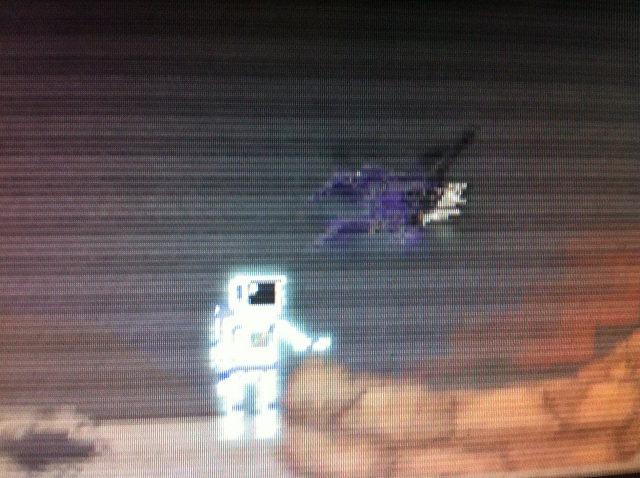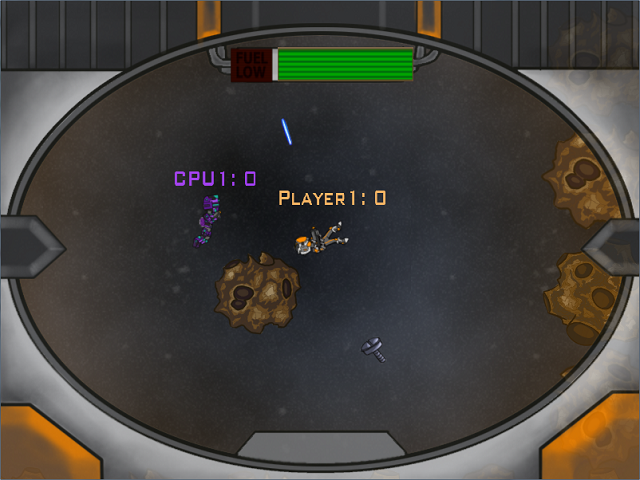After that, I headed over to the MICA student projects, which featured two space-themed games built into retro-styled arcade cabinets. Midnight Astronaut, in a standup machine with a joystick and two buttons, caught my attention first with its dissonant ambiance and static video filter effect.
I took control of a space explorer on a 2D plane. Walking left or right soon revealed men with guns shuffling back and forth behind impassible sandbag enclosures. I could use one button to lift either of these men into the air as if by telekinesis, causing him to cry, “No! Put me down!” through an eerie walkie-talkie effect. The other input did nothing. A little odd…and intriguing. I wanted to know more, but unfortunately, the girl working the table had no idea what was going on.
She took me over to Discoursi, a game for two players with a joystick and two buttons for each. Players look down on a flat screen while facing one another, an act that creates a more intimate feel. That’s quite clever because the game appears to be about fostering a harmonious relationship.
Each player controls a separate ball of energy connected through a power beam. You need to stick close together while collecting other, floating concentrations of visible energy of differing colors in space. If you stretch too far apart, you split, and it’s game over.
My host and I weren’t particularly skilled at Discoursi, but we laughed every time one or both of us realized that we were watching the wrong energy ball, failing spectacularly at staying together. At this point, Midnight Astronaut’s screen changed, so I went back over to take another look.
Now my character was spinning in the cold vacuum of space while various objects floated by. Using my “telekinesis” hand, I could attract these things, and now the other button allowed me to eject them at high velocity in a direction of my choosing. Still wondering how this all fit together, my eye caught the University of Maryland, Baltimore County (UMBC) Game Developers Club sign over a row of monitors.
I’m a UMBC alum, so I was naturally curious. I sat down to Cosmoknights, a game that project lead Jonathan Moriarty conceived from his love of science fiction and the post-World War II space race between the U.S. and the Soviet Union.
I took control of an astronaut floating in the void looking for giant screws to fix his broken ship and fended off other players trying to rebuild their own crafts. I thought of this as a kind of blend between the premise of ToeJam and Earl and the gameplay of Asteroids.
Moriarty explained that Cosmoknights is “a simple multiplayer game that people can pick up and play without a lot of effort.” In the demo, I was only able to compete against computer A.I. characters, but the concept was clear enough.
These student projects from MICA and UMBC might not be ready for primetime, but they pushed forward unique concepts that embody the same space-exploring spirit I had already seen in the more polished works of Bitty Bash and Seven Hills.
Out of everything I saw at Gamescape, I left the festival this year thinking mostly of these games and their creators. Maybe it was the new directions or minor tweaks to existing formulas that hinted toward something unique. Maybe it was clever blends of form and function. Or maybe I’m just marveling at the possibilities.
VentureBeat's mission is to be a digital town square for technical decision-makers to gain knowledge about transformative enterprise technology and transact. Learn More


